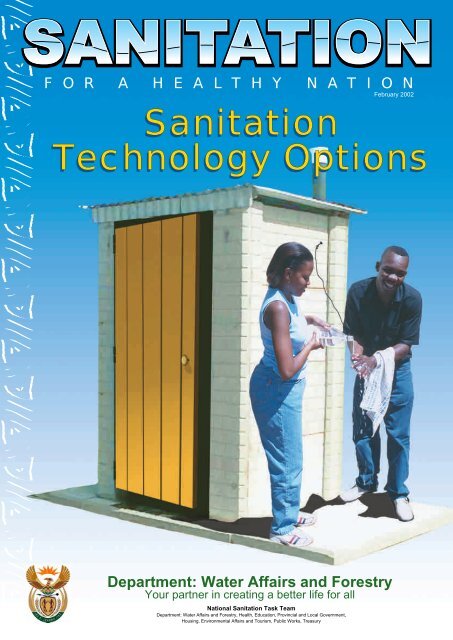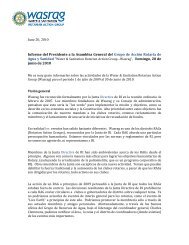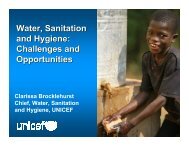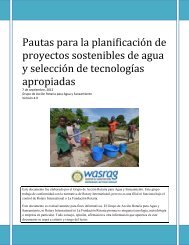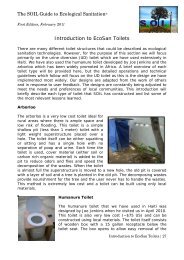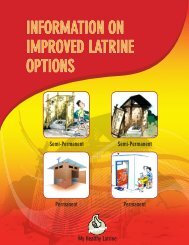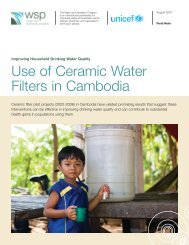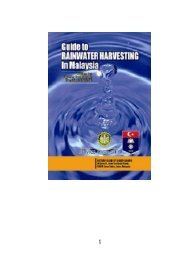Sanitation Technology Options Sanitation ... - GreenNexxus
Sanitation Technology Options Sanitation ... - GreenNexxus
Sanitation Technology Options Sanitation ... - GreenNexxus
Create successful ePaper yourself
Turn your PDF publications into a flip-book with our unique Google optimized e-Paper software.
F O R A H E A L T H Y N A T I O N<br />
February 2002<br />
<strong>Sanitation</strong><br />
<strong>Technology</strong> <strong>Options</strong><br />
Department: Water Affairs and Forestry<br />
Your partner in creating a better life for all<br />
National <strong>Sanitation</strong> Task Team<br />
Department: Water Affairs and Forestry, Health, Education, Provincial and Local Government,<br />
Housing, Environmental Affairs and Tourism, Public Works, Treasury
F O R A H E A L T H Y N A T I O N<br />
Introduction<br />
The full range of technical options for providing adequate basic sanitation is still not widely understood. In particular, there<br />
is little appreciation of the long-term financial implications of operating the various sanitation systems. As a result, communities<br />
and local governments are currently choosing technical options that, in the long term, are unaffordable and unsustainable.<br />
Complications arise from the wide range of options available and the differing environments in which they must be<br />
implemented. Experience shows that it is important to allow local solutions to be developed. The options include the<br />
ventilated improved pit toilet in all its variations, composting toilets and on-site wet systems such as septic tanks, and full<br />
water borne systems.<br />
Communities often face choices ranging from single pit ventilated improved latrines to double ventilated improved pit latrines<br />
to urine diversion/composting latrines. These options promote household management of operation and maintenance. (In<br />
most cases, the cost of emptying a single pit every five years is estimated at between R35 and a still-affordable R60.)<br />
Where higher levels of service are chosen, the costs are a lot higher - as much as R500 per household per annum. The<br />
initial capital cost is also dependent on the choice of technology. One of the lessons learnt from the DWAF programme is<br />
that it is possible to provide on-site dry systems for an initial, capital outlay of less than R1000. The Archloo, which is<br />
provided to many cholera-affected areas, is an example of a facility that can be provided at a cost of R600 using local<br />
materials and local labour - and that can be put into large-scale production. However, such provision must be coupled with<br />
health and hygiene promotion if health improvements are to be ensured.<br />
In this document you will read more about the various technical options that meet the requirements for basic sanitation.<br />
These need to be considered within all the sustainability requirements, e.g. affordability, operation and maintenance. The<br />
options are divided into two categories: Dry on-plot systems (that do not require water for operation) and wet systems (that<br />
do require water for operation).The following information is provided for each technical option described:<br />
• A technical drawing of the recommended option<br />
• A description of the options<br />
• An explanation of the principles of operation<br />
• Operational and institutional requirements<br />
• A summary of costs<br />
• Notes on previous user experiences and comments on these<br />
Technical guidelines are available from the Department of Water Affairs and Forestry for on-site dry sanitation.<br />
Please note: The capital cost of a given technology varies widely - depending on location, locally available materials,<br />
construction method, extent of existing infrastructure, etc.<br />
<strong>Options</strong> not recommended<br />
Unimproved pit toilet<br />
• This system is not recommended (subject to bad smells and insect infestation)<br />
A top-structure around and /or over a pit, generally unlined where soil conditions allow, with a pedestal or squat-plate.<br />
Chemical toilet<br />
• This system is not recommended (expensive and temporary)<br />
Various modern types. These utilise a water-diluted chemical in a receptacle below the toilet seat to render excreta harmless<br />
and odourless. These are generally standalone units.<br />
Bucket toilet<br />
• This system is not recommended (unhygienic sanitation system, environmentally undesirable)<br />
A top-structure with the seat positioned above a bucket or other container located in a small compartment beneath.<br />
Communal toilets<br />
• This system is not recommended for household use (unhygienic)<br />
Toilet ”blocks”, which may be based on dry or wet systems as, outlined above.<br />
References:<br />
Franceys, Pickford & Reed (WEDC) “A guide to the development of on-site sanitation”, WHO 1992. • SMLC, Johannesburg, report to Executive Committee, “Review of sanitation in<br />
informal settlements” 1999. • Guy Pegram, “A protocol to support peri-urban sanitation provision in the GJMC”, final draft, 2000. • Julia du Pisani, “Providing <strong>Sanitation</strong> in South Africa”,<br />
unpublished draft. • The Applicability of Shallow Sewer Systems in South Africa, Guy Pegram and Ian Palmer July 1999.
Dry on-plot systems<br />
Ventilated Improved Pit (VIP) toilet<br />
Fly screen<br />
Vent pipe<br />
Air (ventilation)<br />
Seat cover<br />
Pedestal<br />
Cover slab<br />
Pit collar<br />
(May be extended<br />
to base of pit in poor<br />
ground conditions).<br />
Hand dug<br />
or mechanically<br />
dug pit<br />
A top-structure over a pit. The pit is vented by a pipe over which a fly-screen is fixed. The pit may be lined (recommended<br />
where emptying is required), or unlined where soil conditions allow.<br />
Principles<br />
of operation<br />
Operational and<br />
institutional<br />
requirements<br />
Costs<br />
Experience and<br />
comment<br />
Waste drops into the pit where<br />
organic material decomposes<br />
and liquids percolate into the<br />
surrounding soil. Continuous<br />
airflow through the top-structure<br />
and above the vent pipe<br />
removes smells and vents gases<br />
to the atmosphere. A darkened<br />
interior is maintained causing<br />
insects entering the pit to be<br />
attracted towards the light at the<br />
top of the vent pipe and trapped<br />
by the fly screen. A separate<br />
hand washing facility is required.<br />
Locate to prevent ingress of<br />
storm water to pit, as well as in<br />
consideration of local<br />
groundwater use and conditions.<br />
Does not accept domestic<br />
wastewater. Cannot be placed<br />
inside house. Ensure access for<br />
mechanical pit-emptying and<br />
availability of sludge treatment<br />
and disposal where required.<br />
Ensure repair/replacement of<br />
damaged/worn materials.<br />
Capital: may range from R600-<br />
R3000, depending on<br />
householder input and choice of<br />
materials.<br />
Operating: R60 per year if<br />
emptied once in 5 years.<br />
Widely used internationally and<br />
in rural and peri-urban areas of<br />
South Africa. Most successful in<br />
water-scarce environments.<br />
Failures generally due to<br />
inadequate user education<br />
and/or poor design and<br />
construction. Costly adaptations<br />
can result where shallow rock<br />
or shallow water tables occur.
Ventilated Improved Double Pit (VIDP) toilet<br />
Fly screen<br />
Vent pipe<br />
Air (ventilation)<br />
Swap pedestal<br />
and vent pipe<br />
from other side<br />
if pit to be used<br />
Seat cover<br />
Pedestal<br />
Drop hole and<br />
vent pipe hole<br />
sealed when<br />
pit not in use<br />
Moveable cover<br />
slab (so that pit<br />
can be emptied)<br />
Full pit<br />
Lined and sealed<br />
central wall<br />
A single top-structure over 2 shallow pits, side by side. Only one pit - vented by a pipe protected with a fly screen - is in<br />
use at any time. Generally lined and the central wall fully sealed to ensure isolation of one pit from the other.<br />
Principles<br />
of operation<br />
Operational and<br />
institutional<br />
requirements<br />
Costs<br />
Experience and<br />
comment<br />
As for the VIP toilet.<br />
One pit is used until filled to<br />
within about half a metre of the<br />
top. The defecation and vent<br />
pipe holes are then completely<br />
sealed and the other pit used.<br />
The contents of the first pit are<br />
dug out after a period of at least<br />
two years, once the contents<br />
have become less harmful.<br />
As for the VIP toilet, except that<br />
promotion of manual emptying<br />
by the householder is usual, and<br />
use of decomposed waste as a<br />
soil conditioner possible.<br />
Suitable disposal site necessary.<br />
Capital: R2 500-R4 500<br />
depending on householder input.<br />
Operating: R35-R135 every 2<br />
years depending on local<br />
government involvement,<br />
householder willingness to<br />
handle waste, disposal options.<br />
Resistance to handling of<br />
decomposed waste and timely<br />
changeover of pits by<br />
householders has often been<br />
overcome through education and<br />
over time - both internationally<br />
and in SA. This VIP alternative<br />
is often applicable where rocky<br />
or groundwater conditions<br />
prohibit deep excavation.
Composting/urine diversion (UD) toilet<br />
Fly screen<br />
Vent pipe<br />
Air (ventilation)<br />
Access cover<br />
Seat cover<br />
Urine diversion<br />
Pedestal<br />
Urine outlet pipe<br />
to soakaway or<br />
collection pot<br />
Turning and removal<br />
of composted material<br />
by hand<br />
A single top-structure over a sealed container, which could be one of two chambers side by side (as for the VIDP), with<br />
access for the removal of decomposed waste. A vent pipe may be installed to encourage drying of the waste.<br />
Principles<br />
of operation<br />
Operational and<br />
institutional<br />
requirements<br />
Costs<br />
Experience and<br />
comment<br />
Waste is deposited in the<br />
chamber and dry absorbent<br />
organic material, such as wood<br />
ash, straw or vegetable matter<br />
is added after each use to<br />
deodorise decomposing faeces<br />
and/or control moisture and<br />
facilitate biological breakdown<br />
(composting). Urine may be<br />
separated/diverted through use<br />
of specially adapted pedestals.<br />
This may be collected and used<br />
as a fertiliser. In desiccation<br />
systems, ventilation encourages<br />
the evaporation of moisture.<br />
Does not accept domestic<br />
wastewater. Ensure ease of<br />
access by householder and<br />
promotion of manual ‘turning’ of<br />
compost and removal of<br />
composted/desiccated material.<br />
Suitable disposal site/area<br />
necessary.<br />
Capital (variable depending on<br />
system and householder input):<br />
R3 000-R4 000 for commercial<br />
systems.<br />
Operating: R35-R500 per<br />
annum, depending on local<br />
government involvement and<br />
householder willingness to<br />
handle waste, and disposal<br />
options.<br />
Control of moisture content is<br />
vital for proper operation.<br />
Contents often become too wet,<br />
making the vault difficult and<br />
unhygienic to empty, as well as<br />
malodorous. UD systems in SA<br />
still being monitored but appear<br />
to be accepted by certain<br />
communities and working<br />
without significant problems.<br />
Burning of compost prior to<br />
removal also being tested in SA.<br />
Proprietary systems have been<br />
piloted in SA, generally with<br />
inconclusive results as to their<br />
likely success on a large scale<br />
and under varying conditions.<br />
User educational requirements<br />
and continuous input significant<br />
for proper operation in terms of<br />
the composting process.
Wet systems<br />
Pour-flush toilet<br />
Water tank to be filled<br />
by hand or use a<br />
separate container<br />
Seat cover<br />
Low flush pedestal<br />
Access cover<br />
Water trap<br />
Lined pit<br />
A toilet with a water-seal arrangement: a pan trap fitted into the floor slab, and optionally discharging through a short stretch<br />
of pipe or channel.<br />
Principles<br />
of operation<br />
Operational and<br />
institutional<br />
requirements<br />
Costs<br />
Experience and<br />
comment<br />
After defecation, the pan<br />
requires flushing with a few litres<br />
of water. The water retained in<br />
the pan provides a seal against<br />
smell, flies and mosquitoes.<br />
Appropriate for small volumes<br />
of water and can accept<br />
domestic wastewater - generally<br />
carried by hand to the latrine.<br />
Ensure access for mechanical<br />
emptying of contained waste,<br />
and suitable subsoil drainage<br />
(high reliance on the soil<br />
environment in rendering the<br />
effluent harmless) and/or<br />
availability of sludge treatment<br />
and disposal.<br />
Capital: R2 000-R3 500 which<br />
can increase where soils are not<br />
well suited to drainage.<br />
Operating: R150-R300 per<br />
annum where subsoil drainage<br />
is available.<br />
International acceptance<br />
demonstrated where water is<br />
used for anal cleansing and users<br />
squat. Blockages occur through<br />
use of inappropriate anal<br />
cleansing material. Offset pourflush<br />
can allow location of toilet<br />
inside house, but generally larger<br />
flushing volumes are required.<br />
Experience in SA has seen<br />
failures through lack of user<br />
education and/or poor design and<br />
construction, use where<br />
inappropriate and limited<br />
provision of affordable emptying<br />
service.
Aqua-privy and soakaway<br />
Fly screen<br />
Vent pipe<br />
Water tank may<br />
be hand filled<br />
Air (ventilation)<br />
Seat cover<br />
Low flush pedestal<br />
Access cover<br />
Scum<br />
Down pipe maintained<br />
below water level<br />
Liquid<br />
Sludge<br />
Soakaway<br />
(soakpit or drainage trench)<br />
Water tight tank<br />
Digester<br />
A toilet with a water-seal arrangement: a straight or curved chute running from the seat to below the water level with some<br />
form of waste collection and disposal system.<br />
Principles<br />
of operation<br />
Operational and<br />
institutional<br />
requirements<br />
Costs<br />
Experience and<br />
comment<br />
After defecation, the pan<br />
requires flushing with a few litres<br />
of water. An aqua-privy requires<br />
the addition of water to keep the<br />
end of the chute submerged.<br />
Containment of the waste may<br />
vary from a sealed container to<br />
a solids collection system and<br />
effluent soakaway.<br />
Appropriate for small volumes<br />
of water and can accept<br />
domestic wastewater - generally<br />
carried by hand to the latrine.<br />
Ensure access for mechanical<br />
emptying of contained waste,<br />
and suitable subsoil drainage<br />
(high reliance on the soil<br />
environment in rendering the<br />
effluent harmless) and/or<br />
availability of sludge treatment<br />
and disposal.<br />
Capital: R2 000-R3 500 which<br />
can increase where soils not well<br />
suited to drainage.<br />
Operating: R150-R300 per<br />
annum where subsoil drainage<br />
is available.<br />
International acceptance<br />
demonstrated where water used<br />
for anal cleansing and users<br />
squat. Blockages occur through<br />
use of inappropriate anal<br />
cleansing material. Experience<br />
in SA has seen failures through<br />
lack of user education and/or<br />
poor design and construction,<br />
use where inappropriate and<br />
limited provision of affordable<br />
emptying service.
Conservancy tank<br />
Fly screen<br />
Vent pipe<br />
Air (ventilation)<br />
Full / low flush toilet<br />
Water trap<br />
Access cover<br />
Liquid<br />
Water<br />
tight<br />
tank<br />
Sludge<br />
A storage system, i.e. a sealed tank, where low-flow or full-flush toilet systems are used.<br />
Principles<br />
of operation<br />
Operational and<br />
institutional<br />
requirements<br />
Costs<br />
Experience and<br />
comment<br />
Waste is flushed into the tank<br />
where it is contained in isolation<br />
from the surrounding<br />
environment before removal by<br />
tanker for treatment.<br />
Tank sizing dependent on flush<br />
volumes, domestic wastewater<br />
levels and frequency of<br />
emptying. Ensure access for<br />
mechanical emptying and<br />
availability of treatment and<br />
disposal facilities.<br />
Costs depend on size and<br />
emptying frequency.<br />
Cost: At R2 000 - R5 000<br />
depending on top structure and<br />
tank volume.<br />
Operating: R550 per household<br />
per annum (based on an<br />
estimated emptying cost of R181<br />
per tank) assuming the tank is<br />
emptied, on average, 3 times<br />
per year.<br />
Widely used, particularly in more<br />
sensitive soil and geohydrological<br />
environments.
Full bore waterborne sewerage<br />
Wastewater treatment works<br />
To river<br />
Tertiary<br />
treatment<br />
Secondary<br />
treatment<br />
Primary<br />
treatment<br />
Inlet works<br />
Full flush<br />
toilet<br />
Water trap<br />
Rodding eye<br />
Boundary<br />
fence<br />
Roadway<br />
Household wastewater<br />
Sewer in road reserve<br />
An in-house full-flush toilet connected to a sewer (pipe) network which drains to a wastewater treatment facility.<br />
Principles<br />
of operation<br />
Operational and<br />
institutional<br />
requirements<br />
Costs<br />
Experience and<br />
comment<br />
Waste from the toilet, and<br />
possibly domestic wastewater,<br />
is flushed using significant<br />
volumes of water into the sewer<br />
system for removal to a<br />
treatment facility. There are<br />
several types of such facilities<br />
and these treat effluent to high<br />
standards prior to discharge into<br />
the aquatic environment.<br />
Requires a reliable and<br />
uninterrupted household water<br />
connection and spatially regular<br />
permanent settlements. Specific<br />
design criteria must be applied<br />
throughout the sewerage<br />
network. Skilled, organised and<br />
effective operation and<br />
maintenance capability is<br />
required for sewers and the full<br />
functioning of wastewater<br />
treatment facilities.<br />
Capital: R6 000-R7 000 taking<br />
bulk and sewerage costs into<br />
account.<br />
Operating: R400-R800 per<br />
annum.<br />
Widely used and generally the<br />
aspiration of all South Africans<br />
although unaffordable to many,<br />
particularly in terms of access<br />
to sufficient volumes of<br />
household water. Appropriate<br />
anal cleansing material is<br />
required. The health consequences<br />
of failure are<br />
devastating in comparison to onsite,<br />
dry sanitation.
Septic tank and soakaway or small bore solid-free sewer<br />
Wastewater treatment works<br />
To river<br />
Tertiary<br />
treatment<br />
Secondary<br />
treatment<br />
Primary<br />
treatment<br />
Inlet works<br />
Scum<br />
Liquid<br />
Sludge<br />
Full flush toilet<br />
Water trap<br />
Septic tank<br />
Access cover<br />
To option<br />
A or B<br />
B<br />
A<br />
Small bore sewer to<br />
main sewer in road<br />
Soakaway<br />
(soakpit or drainage trench)<br />
Septic tank and soakaway: An in-house full flush-toilet connected via pipe and plumbing fixtures to an underground<br />
watertight settling chamber (the ‘digester’) with a liquids outlet to a subsoil drainage/soakaway system.<br />
Small bore solid-free sewer: An in-house toilet discharging to a septic tank (or on-site digester) with liquids disposal via<br />
a small diameter sewer to a central collection sump or existing sewer system.<br />
Principles<br />
of operation<br />
Operational and<br />
institutional<br />
requirements<br />
Costs<br />
Experience and<br />
comment<br />
Septic tank and soakaway<br />
Waste from the toilet, and<br />
generally domestic wastewater,<br />
is flushed into the settling<br />
chamber where it is retained for<br />
at least 24hrs to allow settlement<br />
and biological digestion. Partially<br />
treated liquids then pass out of<br />
the tank and into the subsoil<br />
drainage/soakaway system.<br />
Digested sludge gradually builds<br />
up in the tank and requires<br />
eventual removal by tanker.<br />
Requires a reliable household<br />
water connection. Specific<br />
design criteria must be applied<br />
to the settlement tank and<br />
soakaway system. This option<br />
is applicable only in areas of low<br />
settlement density and where<br />
soils have a high ability to drain<br />
effluent away. Ensure access<br />
for emptying of tanks by vacuum<br />
tanker, as well as availability of<br />
sludge treatment and disposal.<br />
Capital: R7 000-R8 500.<br />
Operating: R200-R450 per<br />
emptying, depending on<br />
emptying frequency.<br />
Widely used by formal rural<br />
households and farming areas,<br />
where reliable water supply is<br />
available. Provides a high level<br />
of service and user convenience.<br />
Failures due to poor design and<br />
construction, and use of<br />
inappropriate anal cleansing<br />
material. Soakaway system is<br />
particularly prone to failure in<br />
the long-term if detailed soil<br />
testing is not carried out.<br />
Small bore solid-free sewer<br />
As for the septic tank and<br />
soakaway except that the liquid<br />
effluent is conveyed by a system<br />
of small-diameter pipes to a<br />
communal treatment point<br />
(which may be off-site treatment<br />
works reached either via existing<br />
sewerage or by tanker).<br />
Although its water requirements<br />
may be less than those of a<br />
septic tank and soakaway, a<br />
household connection is needed.<br />
Ensure access for emptying of<br />
septic tank, as well as availability<br />
of sludge treatment and disposal.<br />
Routine maintenance of pipe<br />
network essential.<br />
Within the septic tank and<br />
soakaway range detailed above<br />
if septic tank systems already in<br />
place, otherwise capital cost<br />
much higher.<br />
Not widely used in South Africa,<br />
except where existing septic tank<br />
and soakaway systems have<br />
been converted for convenience<br />
and/or environmental reasons.<br />
Failures as for septic tanks<br />
above, and due to lack of<br />
maintenance of the pipe<br />
network.
Shallow sewerage<br />
Wastewater treatment works<br />
To river<br />
Tertiary<br />
treatment<br />
Secondary<br />
treatment<br />
Primary<br />
treatment<br />
Inlet works<br />
Low flush<br />
toilet<br />
Water trap<br />
Sewer from<br />
next house<br />
Inspection box<br />
Junction box<br />
A toilet, usually in-house, flushed using lower volumes of water than either conventional sewerage or septic tanks, to smaller<br />
diameter sewers laid at flatter gradients and shallower depths between dwellings on a block. On-site shallow inspection<br />
chambers are provided.<br />
Principles<br />
of operation<br />
Operational and<br />
institutional<br />
requirements<br />
Costs<br />
Experience and<br />
comment<br />
Waste from the toilet and<br />
possibly domestic wastewater,<br />
but at much lower volumes than<br />
for conventional sewerage, is<br />
flushed into the on-site sewerage<br />
system and progressively<br />
washed down to either a<br />
dedicated treatment facility or<br />
into street sewers and then on<br />
to a major treatment works.<br />
Requires reliable household<br />
availability of water and high levels<br />
of connection into the sewerage<br />
system are necessary. Can,<br />
however, be laid out in less formal<br />
and spatially irregular settlements.<br />
Less stringent design criteria - but<br />
organised and effective operation<br />
and maintenance capability is<br />
required. This can be delegated<br />
to residents for on-site sewers.<br />
Significant user education and<br />
acceptance of shared<br />
management of the system is<br />
critical.<br />
Capital: R 2500 to R 3000 -<br />
savings of up to 50% over<br />
conventional sewerage capital<br />
costs.<br />
Operational: R300 - R450<br />
assuming that all maintenance<br />
is provided by the service<br />
provider. Drops to R312 where<br />
residents are responsible for<br />
operation and maintenance of<br />
block (not bulk) sewers.<br />
Have not been used widely in<br />
South Africa although used, with<br />
reported success, under a wide<br />
range of conditions in a number<br />
of South American countries,<br />
Ghana, Pakistan and Greece.<br />
Pilot projects have been<br />
completed in Durban and Free<br />
State, with ongoing monitoring<br />
to determine overall success and<br />
sustanability. These indicate<br />
savings of up to 50% over<br />
conventional sewerage capital<br />
costs.
Who can be contacted<br />
National <strong>Sanitation</strong> Task Team<br />
Department of Water Affairs and Forestry<br />
Ms T Mpotulo<br />
(012) 336 8811<br />
xga@dwaf.pwv.gov.za<br />
Private Bag X313<br />
Pretoria, 0001<br />
Department of Health<br />
Zama Zincume<br />
(012) 312 0503/(012) 323 0796<br />
zincuz@health.gov.za<br />
Private Bag X828<br />
Pretoria, 0001<br />
Department of Education<br />
Charles Sheppard<br />
(012) 321 5470/(012) 321 5478<br />
ShepperdC@edu.pvw.gov.za<br />
Private Bag X895<br />
Pretoria, 0001<br />
Department of Housing<br />
Johan Wallis<br />
(012) 421 1440/(012) 341 2560<br />
johan@housepta.pwv.gov.za<br />
Private Bag X655<br />
Pretoria,0001<br />
Department of Provincial and<br />
Local Government<br />
Zama Nofomela<br />
(012) 334 0750/(012) 334 0769<br />
zama@dso.pwv.gov.za<br />
Private Bag X804<br />
Pretoria ,0001<br />
Department of Environmental<br />
Affairs and Tourism<br />
Lucas Mahlangu<br />
(012) 310 3536/(012) 320 1167<br />
Imahlangu@ozone.pwv.gov.za<br />
Private Bag X447<br />
Pretoria, 0001<br />
Department of Treasury<br />
Simon Maphaha<br />
(012) 326 6311/(012) 315 5151<br />
simon.maphaha@treasury.co.za<br />
Private Bag X115<br />
Pretoria, 0001<br />
Department of Public Works<br />
Lorraine Malebo<br />
(012) 337 2764<br />
lorraine@dpw.gov.za<br />
Private Bag X65<br />
Pretoria, 0001<br />
SALGA<br />
Mr Thabo Mokoene (CEO)<br />
(012) 338 6700/29<br />
tmokeena@salga.org.za<br />
PO Box 2094<br />
Pretoria, 0001<br />
DWAF Regional Offices<br />
WESTERN CAPE<br />
Lionel Visagie<br />
(021) 950 7152<br />
odg@dwaf-wcp.wcape.gov.za<br />
Private Bag X16<br />
Sanlamhof<br />
7532<br />
MPUMALANGA<br />
Richard Mbambo<br />
(013) 752 4183<br />
6bc@dwaf.mpu.gov.za<br />
Private Bag X11259<br />
Nelspruit, 1200<br />
KWAZULU-NATAL<br />
Viv Naidoo<br />
(031) 336 2763<br />
Naidoov@dwaf.kzntl.gov.za<br />
P O Box 1018<br />
Durban, 4000<br />
FREE STATE<br />
Gabriël Hough<br />
(015) 430 3134<br />
4bj@dwaf.ncape.gov.za<br />
P O Box 528<br />
Bloemfontein, 9300<br />
NORTHERN CAPE<br />
Antonino Ross<br />
(053) 831 4125/(053) 831 5682<br />
rossa@dwaf.ncape.gov.za<br />
P O Box 416<br />
Kimberley, 8300<br />
EASTERN CAPE<br />
Mfusi Mpendu<br />
(043) 643 3011<br />
mpendud@dwaf.ecape.gov.za<br />
Private Bag X7485<br />
King Williams Town, 5600<br />
GAUTENG<br />
Johan Enslin<br />
(012) 392 1300<br />
enslinj@dwaf-nuc.pwv.gov.za<br />
Private Bag X8007<br />
Hennopsmeer, 0046<br />
NORTH WEST<br />
Logogang Bogopa<br />
(018) 384 3270/(018) 392 2998<br />
mochethandi@dwaf.pwv.gov.za<br />
Private Bag X5, Mmabatho, 2735<br />
NORTHERN PROVINCE<br />
Masia Mgwambani<br />
(015) 290 1238/(015) 295 3250<br />
mgwambm@dwaf-ptg.pwv.gov.za<br />
Private Bag X9506<br />
Pietersburg, 0700


